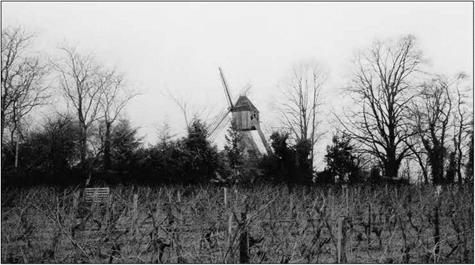Windmills: medieval innovations?
The use of wind energy (over and above the powering of sailboats) had begun on the Persian-Afghan plateau in the 7th century. It then spread to China from the 12th century as we have seen in the preceding chapter. At the beginning of this century, windmills began to see rapid development in Europe as well. Did the idea come from the Crusades, or perhaps from Sicily or Spain? Or did it arise, as we have proposed for tidal mills, quite independently? After two centuries of Muslim occupation, Sicily became Normand from 1061. The geographer al-Idrissi, residing in the court of the Normand king Roger II, gives us a hint of the Sicilian use of the horizontal-wheel Persian mill: “One can find there (in the Sicilian village of Calatubo) a quarry where stones are cut for both water mills and mills called “Persian”.”[474]
 |
Therefore it seems possible that the idea of using wind instead of water came from the Orient. But the medieval European concept of a windmill, with blades in a vertical plane, is quite different from that of the Persian mill.
First of all, in Europe these were post mills. The mechanism of a post mill sits in a wooden enclosure. The mill’s four blades are constituted of cloth stretched on a lightweight wooden frame to which the sails are tied, apparently in nautical fashion. At night the cloth sails are removed and folded. The entire assembly, including both the sails and the machinery within the enclosure, can be rotated around a sturdy oak pivot solidly anchored or lashed to the ground, thus making it possible to orient the sail into the wind. A long beam protrudes from the rear of the enclosure, like a tail or lever, to facilitate rotation of the mill. It is said that in Lincolnshire, a horse harnessed to this beam got entangled in the straps and dragged the mill around two full turns before the frantic animal could be calmed down.[475]
This concept had its roots either in the flatlands of Flanders or in England. The known points of reference in Flanders are from 1114 (the Hofland mill) and 1127 (North mill). Those in England are from 1137, when a text mentions the gift of a windmill to the abbey ofReading; then in 1155, Sussex. Four other references to mills between 1180
|
Figure 9.8 An ancient post mill at the edge of the Loire valley, upstream of Saumur (photo by the author). |
and 1190 are from Flanders, at the mouth of the Somme River, and here are some twenty other references from England. This type of mill then spreads rapidly to other regions, since evidence exists from Germany in 1222, from Denmark in 1259, and from Holland in 1274. Some 120 windmills are known to have existed in the Ypres region in the 13th century. Others are found in Russia and at Venice in the 14th century.[476]
A second type of mill with its blades in a vertical plane appears in the Mediterranean area in the 13th century. In this region it was probably very difficult to find the kind of
 Figure 9.9 Remains of a tower mill on a hilltop in the northern extremity of Corsica. In this particular case, the unit cannot be turned into the wind (photo by the author).
Figure 9.9 Remains of a tower mill on a hilltop in the northern extremity of Corsica. In this particular case, the unit cannot be turned into the wind (photo by the author).
Figure 9.9 bis Ancient windmills in Crete, on the Lassithi plateau (photo by the author).
massive wood necessary for fabrication of a pivot. Thus was born the tower mill, in which the mechanism and the millstones are inside a round masonry tower. Only the conical roof of the tower, through which the horizontal axle extends, rotates to orient the sail into the wind. The sail itself also evolves to become more rigid in this kind of mill. Before long, and especially in Mediterranean regions, the technique of a sail stretched over a wooden frame, as for the pivoting mill, begins to disappear. Now each sail is of triangular shape like the lateen sails of Mediterranean sailboats, and is rigged on one spoke of a wheel as it would be on the mast of a ship. The sail is shaped by being sheeted to the neighboring spoke. This new concept for a mill apparently first appears in France or in Portugal in the middle of the 13th century; it then spreads toward the eastern Mediterranean basin during the 14th and 15th centuries.[477] A tower mill dating from 1220 can be seen in Normandy (the Moulin de Pierre of Hauville).[478]







Leave a reply